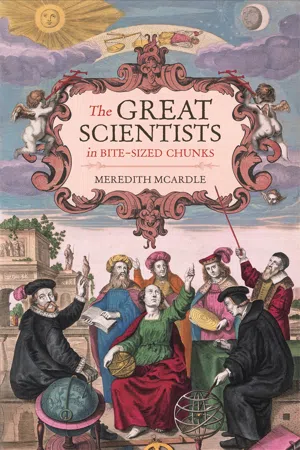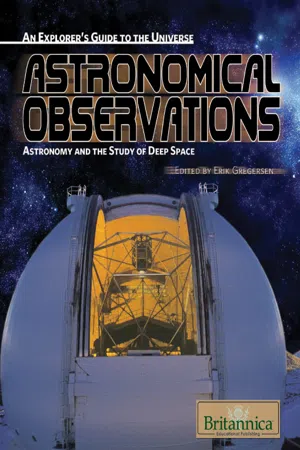Physics
Astronomical Objects
Astronomical objects refer to any celestial body or structure that exists in space, such as stars, planets, galaxies, asteroids, and comets. These objects are studied by astronomers to understand their properties, behavior, and evolution, and to gain insights into the workings of the universe.
Written by Perlego with AI-assistance
Related key terms
Related key terms
1 of 4
Related key terms
1 of 3
3 Key excerpts on "Astronomical Objects"
- Janice VanCleave(Author)
- 2020(Publication Date)
- Jossey-Bass(Publisher)
Part III ASTRONOMYAstronomyis the study ofcelestial bodies, which are natural bodies in space. In other words, astronomy is the study of the physical Universe as a whole.Universeis the name for all things in space, including Earth. At one time, the Universe was considered to be composed of only what could be seen in the sky with the unaided eye; everything in the sky seemed to rise above the horizon, move across the sky, and set below the opposite horizon. This put Earth at the center of the Universe with all other celestial bodies circling it. Thisgeocentricmodel that made Earth the center of the Universe did not fit all observations. Thus, in time theheliocentricmodel of the Universe was suggested, with the Sun being the center of the Universe. Both views limited the Universe to only things visible to the unaided eye, which is amazing when you think of how many planets were identified. Early sky observers were only designing models of ourSolar System, which is composed of the Sun with celestial bodies moving around it at different distances.Today, it is known that our Solar System is not the entire Universe; instead, it is a very tiny part of agalaxy(a group of millions of stars, gas, dust, and other celestial bodies) called the Milky Way. This galaxy is just one of many galaxies in the Universe. It is also known that our Sun is not in the center of the Universe, being only in the center of our Solar System, which consists of eight major planets revolving around the Sun.The Universe is much vaster than was believed by early astronomers, and as such we need special ways to measure distances as well as identify the position of visible celestial bodies. You will discover a few of the measuring units used by astronomers as well as how to measure sky distances with your hands.The Sun and other stars areluminous, meaning they produce their own light; planets and moons, however, are nonluminous, but even so they appear to give off light. You will investigate the reflective power of a celestial body, which is called itsalbedo- eBook - ePub
- Meredith MacArdle, Nicola Chalton(Authors)
- 2015(Publication Date)
- Michael O'Mara(Publisher)
HAPTER 1Astronomy and Cosmology: A Scientific View of the UniverseS INCE ANCIENT TIMES , humans have tried to make sense of the universe by observing objects beyond our world – the sun, moon, stars and planets. Babylonian and Egyptian civilizations, realizing that astronomical events are repeated and have cycles, charted star positions and predicted celestial events such as eclipses, comets and the motions of the moon and the brightest stars. Their records formed the basis for timekeeping and navigation.Adopting centuries of observations before them, the ancient Greeks named groups of stars, or constellations, after mythological figures like Orion, the hunter, and Gemini, the twins Castor and Pollux. The forty-eight Western constellations listed by Ptolemy in the first century are among the eighty-eight constellations used to navigate the night skies today. Likewise, the Romans gave us the names for some of our planets; Mercury, Venus, Mars, Jupiter and Saturn. Reflecting the sun, these were seen as bright ‘stars’ in the sky.The invention of the optical telescope in the seventeenth century changed forever the idea of an earth-centred universe. It was soon clear that the universe was much larger than ever imagined. Searching deeper into space, astronomers found more planets of our solar system (Uranus and Neptune), minor planets or asteroids, satellites (moons), dwarf planets (like Pluto), gas clouds, cosmic dust and whole new galaxies.Today’s astronomical instruments include satellite-borne telescopes that detect radiation from faraway cosmic objects, and space probes that can bring back information from other planets. Armed with these tools, astronomers are discovering more about the particles and forces that make up the universe, the processes by which stars, planets and galaxies evolve, and how the universe began. They have also discovered a large part of the universe that cannot be seen with any type of telescope. This ‘dark matter’ is proving to be one of astronomy’s greatest mysteries. - Britannica Educational Publishing, Erik Gregersen(Authors)
- 2009(Publication Date)
- Britannica Educational Publishing(Publisher)
STRONOMICAL OBJECTS AND THEIR MOTIONSO rdinary classical mechanics can describe the motion of a car on a highway, a baseball clearing the outfield fence, or an apple falling from a tree. The same equations that describe the motion of the car, the baseball, and the apple can be applied to the motion of celestial bodies acted on by any of several types of forces. By far the most important force experienced by these bodies, and much of the time the only important force, is that of their mutual gravitational attraction. But other forces can be important as well, such as atmospheric drag on artificial satellites, the pressure of radiation on dust particles, and even electromagnetic forces on dust particles if they are electrically charged and moving in a magnetic field.CELESTIAL MECHANICS
The term celestial mechanics is sometimes assumed to refer only to the analysis developed for the motion of point mass particles moving under their mutual gravitational attractions, with emphasis on the general orbital motions of solar system bodies. This science has evolved from an ad hoc collection of rules of thumb to describe the planetary motions to a finely tuned description of astronomical motion based on Newton’s laws and their fullest description in Einstein’s theory of general relativity.The term astrodynamics is often used to refer to the celestial mechanics of artificial satellite motion. Dynamic astronomy is a much broader term, which, in addition to celestial mechanics and astrodynamics, is usually interpreted to include all aspects of celestial body motion (e.g., rotation, tidal evolution, mass and mass distribution determinations for stars and galaxies, fluid motions in nebulas, and so forth).EARLY THEORIESCelestial mechanics has its beginnings in early astronomy, in which the motions of the Sun, the Moon, and the five planets visible to the unaided eye—Mercury, Venus, Mars, Jupiter, and Saturn—were observed and analyzed. The word planet
Index pages curate the most relevant extracts from our library of academic textbooks. They’ve been created using an in-house natural language model (NLM), each adding context and meaning to key research topics.
Explore more topic indexes
Explore more topic indexes
1 of 6
Explore more topic indexes
1 of 4


